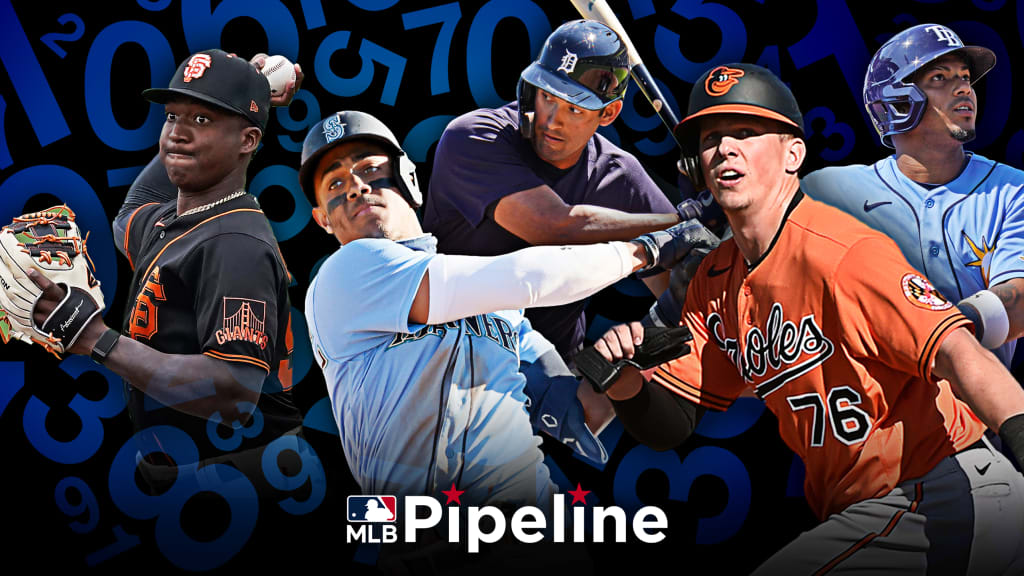
Minor League stats are back. That still feels good to say after no Minor League Baseball at all in 2020. Every night, there are fresh box scores to check. Every day, the sample size on player stats gets a little bigger. About one month into the season, we’re learning more and more about some of the game’s top prospects with the rising and falling of every sun.
So as the numbers grow (or shrink in some cases), it’s important to get a refresher on how to evaluate Minor League numbers. There is much more nuance at the lower levels than there is in the Majors, where good performance typically follows what’s on the tin. A hitter off to a strong start in the Minors might not be doing so well as the numbers alone would indicate. On the flip side, a pitcher with some rough numbers at a given level could be much more effective than meets the statistical eye. Like we said, nuance.
So yes, check ERA, WHIP, batting average, home runs, OPS to your heart’s content. But to understand prospect performance more accurately, you might want to go even deeper. Here are seven rules on how to read Minor League stats:
Keep age in mind
This is true anywhere in sports. A 21-year-old rookie is going to be seen differently than his peer in his prime. But it’s especially noteworthy in the Minors, where ages can vary wildly and some organizations can get aggressive or conservative with their prospect assignments.
The prime example is MLB Pipeline’s top overall prospect Wander Franco. The switch-hitting infielder was three years younger than the average Appalachian League player when he batted .351 for Princeton in 2018. He was four years younger than the average Florida State Leaguer when he produced an .872 OPS for Charlotte two seasons ago. Now 20 years old, he was the youngest player on a Triple-A Opening Day roster. Franco has hit everywhere he has played, and the fact that he has done so at such a young age against much more advanced competition is why so many are high on his hitting potential.
Of course, this goes two ways. Sometimes, organizations will place older players at low levels in hopes of establishing a baseline of success. So if a 23-year-old dominates Low-A, that isn’t necessarily a sign that he should shoot up prospect rankings. It’s just a case of an older player achieving against younger competition and should be treated as such.
There are slightly different age curves for hitting and pitching prospects as well. Teams tend to hold back pitchers a little more out of the gate – in part for health reasons – so it can be even more eye-catching when an arm climbs quickly toward the Majors. Julio Urías reached Class A in his age-16 season and was in the Majors as a 19-year-old. Urías’ numbers in the Minors were solid, but the fact that they came when others his age were still in short-season ball highlighted the promise the Dodgers believe he had.
Experience matters, too
Age is the number. It’s easiest to see and understand. Experience is a little less tangible but can be just as important.
The best example is first-year players coming out of the Draft. For instance, Tyler Soderstrom and Aaron Sabato – the 26th and 27th overall picks from the 2020 Draft – both started their Minor League careers at Low-A. Same area of the Draft. Same starting spot. Except Soderstrom came from the California high-school ranks while Sabato was selected out of the University of North Carolina, where he spent three years facing ACC pitchers. Low-A hurlers should, in theory, be much less of a challenge for Sabato.
This does get tricky in 2021, however. The lost 2020 season meant organizations were in the Wild West of prospect assignments for this year. Players who skipped a level earn more of a grace period in their adjustment time and can be given more leeway in how dominant their numbers need to be, whereas those that are held back must clear a much higher bar. That’s true of any period in time, but it’s especially worth considering in this unique season.
In more normal times, be sure to look out for players repeating a level as well. It can be awesome to see an ERA around 2.00 or an OPS in the quadruple-digits. But if it’s coming from a player who has already seen the level for half a season or more, those numbers should come with a grain of salt.
Incorporate tools and potential
It’s worth pointing out here that MLB Pipeline incorporates future potential grades in its scouting reports, not current ones. So a player with a 55 hit tool is meant to portray that the player will eventually be an above-average hitter in the Majors, not that he is one at present.
With that in mind, power is famously one of the last tools to develop. Young hitters might have the frame for pop but need time to grow into it. Conversely, they might have the killer bat speed to produce stellar slugging numbers but need the experience to develop an approach that allows them to tap into it. Vladimir Guerrero Jr., for instance, didn’t slug above .500 until his third Minor League season and never had more than 20 homers in a Minor League campaign. Now as a 22-year-old, he’s become one of the Majors’ most powerful bats. Mike Trout had more homers in his 2012 rookie season (30) than he did during his entire run in the Minors (23).
Best way to evaluate this? Look for other extra-base hits. Doubles and triples will turn into homers as a player matures. So if a young player with a promising power tool grade has plenty of those two and a relative dearth of homers, take that in stride, knowing the dingers should come in time.
Look for league factors
Not all Minor League circuits are considered equal. The local nature of each league can cause numbers to vary wildly across the board.
Low-A West (i.e. the former California League) – aided by dry heat and those Golden State winds – is historically seen as one of the best environments for hitters across the Minors, and that reputation continues even after losing The Hangar in Lancaster, arguably the Minors’ most hitter-friendly ballpark prior to 2021. Similarly, high elevations in places like Albuquerque, Salt Lake City and El Paso typically lead to crooked numbers in Triple-A West, previously known as the Pacific Coast League.
More pitcher-friendly circuits are those closer to sea level and/or typically deal with cooler weather, like Low-A Southeast, Double-A Northeast and High-A East. Low-A Southeast (i.e. the old Florida State League) is particularly seen as a circuit tilted toward pitchers with its play in stadiums primarily designed for Major League Spring Training. No one hit more than 25 homers in a single FSL season during the 2010s.
In 2019, both Triple-A leagues began using Major League baseballs, rather than those used specifically for the Minors. Much has been made about the liveliness of Major League balls in recent years, and that carried to Triple-A as well. The International and Pacific Coast Leagues were the only full-season circuits to average more than five runs per team per game in 2019. PCL batters, on average, had an .831 OPS. They were also the only full-season leagues with slugging percentages above .400, and they each cleared that mark at .445 (IL) and .447 (PCL). A Triple-A batter hitting a Major League ball to the tune of a .500 slugging percentage and .900 OPS isn’t worthy of the same glowing reports of a slugger who is doing that at Double-A, High-A or Low-A. Triple-A itself needs to be another layer of consideration.
Look for park factors
As if different leagues weren’t enough, the effects different Minor League parks can have on statistical performance shouldn’t be overlooked either. Staying at Triple-A, playing in hitter-friendly Las Vegas can be very different than playing in more of a pitcher’s paradise in Tacoma. Asheville (hitters) and Wilmington (pitchers) are now both in High-A East but couldn’t be further apart in terms of how they affect play. Where prospects make their homes can cause huge swings in their numbers, sometimes through no fault of their own. The new six-game series in 2021 also mean where hitters and pitchers are lucky (or unlucky) to play on the road could cause similar variations.
Park factors can be found for most clubs in this MiLB.com series from the end of 2019, separated by level: Triple-A, Double-A, Class A Advanced and Class A.
That all brings us to…
Check the splits
There are an endless supply of splits that provide additional context needed in prospect evaluation.
Want to know more about a hitter? See how he does against righties compared to lefties, how do his numbers hold up at home versus the road and how does he waver from month to month. Those are also good to check for pitchers, and you can add inning-by-inning breakdowns among the splits to check for that group as well. Pitchers who fall apart through the second time in the order (third, fourth, fifth innings) are more likely to have a future in the bullpen, where they’ll face batters only once.
Consider the organizational plan
Put your thoughts on Moneyball aside. Every farm system has its own player-development philosophies and practices, and those key differences could pop up in a player’s stat sheet.
Consider, for instance, the increased prevalence of piggyback starters. You might look at a pitching prospect’s numbers and notice he has 10 appearances, five starts. Traditionally, that would indicate he is a swingman or emergency starter. In today’s game, organizations may be willing to keep pitchers in lengthened roles for longer, so instead of carrying only five starters, there might a few more than that who piggyback off one another, each getting around four innings. Be sure to check the innings-to-appearance ratio before writing off a pitcher’s numbers as those of a reliever.
